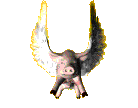
HAARP
As the Santa Anas blow in sporadic bursts from October through March, they present a triple threat of wind, heat and dryness, which often turns the region's hardscrabble flora into explosive fuel for wildfires. While drying out vegetation, the winds fan any flames that ignite, leading to widespread forest fires that in some years span hundreds of thousands of acres.
The infamous winds are especially extreme right now, experts say, because of the huge pressure difference between the area where the moving air originated and where it has ended up.
The Santa Anas develop in the Great Basin, a desert covering most of Nevada and part of Utah. The atmospheric pressure above the Great Basin tends to be high during the colder part of the year. In the Northern Hemisphere, air circulates clockwise around high-pressure areas — the same effect that causes Atlantic hurricanes to curve clockwise — and so the Santa Anas curl around the Great Basin and head west.
Picking up speed as they whoosh through canyons, including the Santa Ana Canyon and mountain passes in the Sierra Nevada mountain range, they end up in the Los Angeles Basin, the low-lying area near the California coast that contains Los Angeles and surrounding counties.
The Los Angeles Basin sits at a much lower elevation than the Great Basin, and the drop in elevation as the winds sweep from one place to the other imbues them with their characteristic hotness and dryness: Air compresses as it descends in , which causes it to rapidly heat up. As its temperature rises, so does its capacity to hold water vapor. Starting as cold, exceptionally dry wind in the Great Basin, the Santa Ana winds grow hot and thirsty as they blow downhill to the Los Angeles area, sucking the moisture out of any plant life they encounter (though that moisture is still not nearly enough to saturate the air). This leaves those areas particularly susceptible to wildfire.
According to Carlos Mechoso, professor of atmospheric and oceanic sciences at the University of California, Los Angeles, there is currently a very high pressure system hovering above the Great Basin.
"That pressure drives the air through the passages in the mountain to the west, and because the pressure difference between the east and the Los Angeles Basin is very big right now, the wind is being pushed very hard," Mechoso told Life's Little Mysteries.
With much of Southern California battling a drought this fall, the wildfire hazard was already big enough before the current Santa Ana episode. For the next few days, firefighters will be on high alert.
- Future Hurricanes Will Get Worse
- Is All the Wild Weather Connected?
- Amazing Video: The Speed of Wildfire
Follow Natalie Wolchover on Twitter @nattyover. Follow Life's Little Mysteries on Twitter @llmysteries, then join us on Facebook.
Thru ND we have gotten some very bad winds-thru the day an easy south gentle breeze till nightfall n then as if some1 had hit a switch the winds come SCREAMING down from the north. Till daybreak n they turn IT off n the breeze comes back from the south-like as if a high pressure ridge had been "created" by lifting the ionospehere. Then again by sundown, the breeze di a 180 n came back HOWLING like DEMONa's
I learned a lot a little too late,Donut learn as I did. Take care & beware,FTG The sun shineth upon the dunghill & isnt corrupted. We fear things in proportion to our ignorance of them. Confutatis maledictis, flammis acribus addictis http://wp.me/PmtmV-4W2
Fully Informed Jury Association




